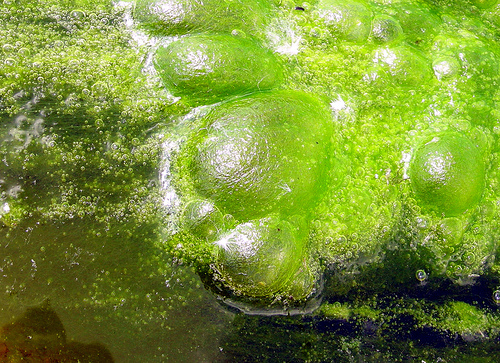Algae biofuel is now being developed as a source of energy for the future, but really algae has been fueling society for a long time. When looking at the components of coal, oil, and natural gas that power our world today, they are all originally comprised of organic materials such as algae. As we currently aim to shift away from fossil fuels because of their non-renewable nature and significant contribution to global warming, we may be going back to using one of fossil fuels’ original organic components.
In an interview Dr. Michael Kagan, a long time environmental researcher and founder of the algae development company Algaenesis, I was introduced to the beneficial uses of algae that make it vital to human and animal life and how Algaenesis has developed a new system of growing it.
The beauty of algae is that it does not have to be grown in fresh water. In fresh, brackish, or salt water Algae grows by photosynthesizes producing a range of products including oils that can be refined into fuel, powerful antioxidants and vitamins, Omega 3 and Omega 6, and there’s even one species that grows octane fuel. Algae should be more integrated into human and animal diets because it has tremendous health properties, and if more accessible, it could feed animals and provide more food in poor areas of the world.
Dr. Kagan explained that researchers have dreamed of algae being widely used to feed the world for 40 to 50 years, but it is difficult to grow, especially inexpensively and in large quantity. Scientists have tried to grow algae in raceway shaped ponds and in vertical tanks called bioreactors, but both systems have experienced setbacks.
Algae ponds have enough volume to grow a significant quantity, but yield has been limited due to insufficient sunlight reaching the lower algae. Algae need sunlight, along with CO2 and water, but indirect sunlight is best for them. Algae ponds have only been able to produce 10-15 grams per square meter per day, because only the thin layer of algae, slightly below the surface, is able to receive proper sunlight. Algae that are deeper than that are sunblocked and do not receive enough light while the surface algae receive too much direct light.
The alternative to an algae pond is a large vertical bioreactor. This method is very expensive due to the cost of building the glass or plastic reactors, as well as the energy cost involved in stirring, and is much less environmentally friendly. Deoxygenating the bioreactor from the algae’s O2 creation is also a difficult process that is necessary because oxygen is like a poison to the algae. Bioreactors are also limited in their size, but the efficiency is a bit higher as they can grow 50-75 grams per square meter per day.
Algaenesis have developed a new method of growing algae that can currently grow up to 150 grams per square meter per day, and also has economic and environmental benefits. Algaenesis technology grows algae in a pond, but enables algae at a depth of up to one meter to obtain proper sunlight and high growth. Their device plus a proprietary low energy pump that rapidly circulates the algae in and out of the light regions have together broken through what Kagan calls the “Light Barrier” to efficient algae growth. The process uses brackish water, inexpensive materials, and low energy.
Improving Algae growing efficiency
Kagan summarized their technology that was invented by Yochanan Zweig as, “The sophisticated devices are cheap to produce, can be put into ponds with algae swimming between them, and are able to distribute 95 percent of the light from the surface into the volume at all times of the day.”
Algaenesis’s goal is to continue improving the technology’s efficiency, but they are now at a strong point and will soon begin building a pilot plant. In terms of the algae’s use, the first objective is to use it for pharmaceuticals, and as the technology and efficiency increase to become more economical, it will eventually be used for fish foods, and even biofuel.
When I asked Kagan if algae would be the main biofuel of the future, he laughed a little and said, “I don’t think so. Algae will hopefully be a huge contributor to feeding the world as a food source, but in terms of biofuel it cannot be the only source. Algae biofuel does have great potential, but the hope for the future is that green energy will be much more ‘democratic’. Algae should be a solid contributor to the myriad of biofuels, photovoltaics, wind, geothermal and hydro energies that will hopefully power our world in the future.”
Algae have been vital to life on earth and can have an expanded role in the near future. Algaenesis has developed a new technology that it hopes will bring algae growth to a new level and make the growing process more environmental and economical.
In addition to Michael Kagan’s work on Algaenesis and other cleantechs like BrightSource (Luz II), he has started the Jewish Climate Initiative, which focuses on using ancient wisdom buried in our faith traditions, and relating it to the current economic and environmental challenges facing us today.
[image via Lee Nachtigal]





I fully agree with the problem of using algae as a bio fuel. It’s really no different than using sugar or corn! We need to shift away from bio fuels and concentrate more on renewable and alternative energy, especeally solar and wind energy.